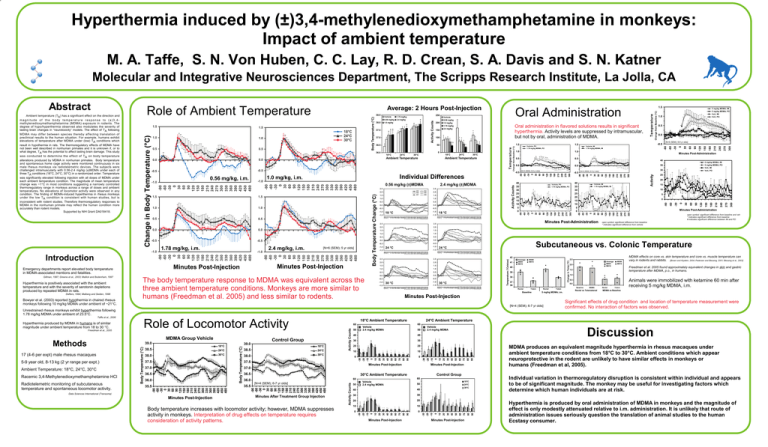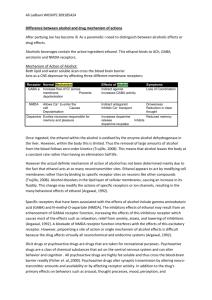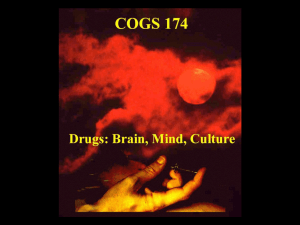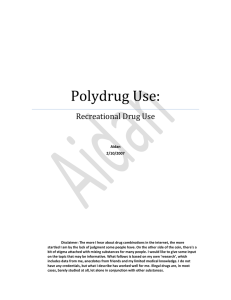Hyperthermia induced by ( )3,4-methylenedioxymethamphetamine in monkeys: Impact of ambient temperature
advertisement

Hyperthermia induced by ( )3,4-methylenedioxymethamphetamine in monkeys: Impact of ambient temperature M. A. Taffe, S. N. Von Huben, C. C. Lay, R. D. Crean, S. A. Davis and S. N. Katner Molecular and Integrative Neurosciences Department, The Scripps Research Institute, La Jolla, CA -90 -60 -30 0 30 60 90 120 150 180 210 240 270 300 330 360 390 420 450 480 -1.0 2.4 mg/kg, i.m. Minutes Post-Injection -30 -20 -10 0 10 20 30 40 50 60 70 80 90 100 110 120 130 140 150 160 170 180 190 200 210 220 230 240 2.5 2.5 2.0 2.0 1.5 1.5 1.0 1.0 0.5 0.5 0.0 0.0 -0.5 -0.5 -1.5 -1.5 2.5 2.5 2.0 2.0 1.5 1.5 1.0 1.0 0.5 0.5 0.0 0.0 -0.5 -0.5 -1.0 -1.0 30 C -1.5 -1.5 42 30 C 41 60 40 30 30 20 20 * Minutes Post-Injection 90 80 70 60 50 40 20 10 * 300 270 240 210 180 150 120 90 60 30 0 -30 -90 Activity 300 270 240 210 180 150 120 90 60 30 0 -30 -60 -90 Vehicle, IM 1.78 mg/kg MDMA, IM # # 25 # 20 # # 15 10 300 270 240 210 180 * 150 90 60 30 -30 * 300 270 240 210 180 150 120 Minutes Post-Administration 90 60 30 0 -30 * * *** -60 -90 0 0 * ********* 120 5 -60 300 30 [N=6 (SEM); 8-9 yr olds] -90 300 270 240 210 180 -60 Change from Baseline ( C) Temperature 35 open symbol: significant difference from baseline and veh * indicates significant difference from baseline # indicates significant difference between IM and PO open symbol: significant difference from baseline * indicates significant difference from vehicle 40 39 38 37 36 Rectal Telem Rectal Telem 5 mg/kg MDMA, i.m. 2.5 Average M405 M416 2.0 M389 M415 MDMA effects on core vs. skin temperature and core vs. muscle temperature can vary in rodents and rabbits. [Brown and Kiyatkin, 2004; Pedersen and Blessing, 2001; Blessing et al., 2003] Freedman et al. 2005 found approximately equivalent changes in skin and gastric temperature after MDMA, p.o., in humans. 1.5 1.0 0.5 0.0 Baseline MDMA Rectal vs Telemetered Rectal Telem Animals were immobilized with ketamine 60 min after receiving 5 mg/kg MDMA, i.m. MDMA vs Baseline Significant effects of drug condition and location of temperature measurement were confirmed. No interaction of factors was observed. Minutes Post-Injection MDMA produces an equivalent magnitude hyperthermia in rhesus macaques under ambient temperature conditions from 18 C to 30 C. Ambient conditions which appear neuroprotective in the rodent are unlikely to have similar effects in monkeys or humans (Freedman et al, 2005). Individual variation in thermoregulatory disruption is consistent within individual and appears to be of significant magnitude. The monkey may be useful for investigating factors which determine which human individuals are at risk. 90 0 80 * * 70 * * 60 * 50 * 40 * 30 * * 20 * 10 * * 0 * * * 10 -10 0 * * * 50 40 10 * 18 C 24 C 30 C -20 Body temperature increases with locomotor activity; however, MDMA suppresses activity in monkeys. Interpretation of drug effects on temperature requires consideration of activity patterns. 50 * Control Group -30 Minutes After Treatment Group Injection Vehicle 2.4 mg/kg MDMA 90 [N=4 (SEM); 6-7 yr olds] * Minutes Post-Injection 30 C Ambient Temperature 60 * 30 * 0 0 * -10 10 * * * -20 * 90 80 * 70 60 50 40 * * 80 Minutes Post-Injection 36.5 35.5 * * * 5 mg/kg MDMA, IM 5 mg/kg MDMA, PO Veh, IM Veh, PO Discussion * Minutes Post-Injection 37.0 36.0 * * 70 35.5 37.5 * * * 60 36.0 0 * * * * 50 36.5 10 * 40 37.0 38.0 * 30 37.5 30 C 20 30 38.0 24 C 20 20 30 C 38.5 30 10 24 C 18 C 30 150 M389 M415 Baseline Vehicle 2.4 mg/kg MDMA 50 40 0 38.5 39.0 60 40 -10 18 C Control Group 50 -20 39.0 MDMA Group Vehicle Vehicle 2.4 mg/kg MDMA 40 35 30 25 20 15 10 5 0 [N=6 (SEM); 8-9 yr olds] 24 C Ambient Temperature -30 Role of Locomotor Activity 120 90 60 30 0 -30 -60 -90 Average M405 M416 [N=4 (SEM); 6-7 yr olds] 60 0.0 Subcutaneous vs. Colonic Temperature 24 C Minutes Post-Injection 18 C Ambient Temperature -0.5 * 40 Minutes Post-Administration -1.0 24 C -1.0 18 C 270 -1.5 240 18 C 210 -1.0 180 -1.0 150 -0.5 120 -0.5 90 0.0 Vehicle, PO 1.78 mg/kg MDMA, PO 60 0.0 40 35 30 25 20 15 10 5 0 30 0.5 0.5 [N=6 (SEM); 8-9 yr olds] # Minutes Post-Administration 0.0 0 0.5 * **** ** 0.0 -30 1.0 * -60 1.5 0.5 -0.5 0.5 1.0 -90 2.0 1.0 -1.5 The body temperature response to MDMA was equivalent across the three ambient temperature conditions. Monkeys are more similar to humans (Freedman et al. 2005) and less similar to rodents. 454 456 458 1.0 1.0 -0.5 Vehicle, IM 1.78 mg/kg MDMA, IM -30 -20 -10 0 10 20 30 40 50 60 70 80 90 100 110 120 130 140 150 160 170 180 190 200 210 220 230 240 1.5 20 Data Sciences International (Transoma) 453 455 457 2.5 Vehicle, PO 1.78 mg/kg MDMA, PO Change in Temp ( C) 1.78 mg/kg, i.m. [N=6 (SEM); 5 yr olds] 10 Radiotelemetric monitoring of subcutaneous temperature and spontaneous locomotor activity. 30 C Temperature ( Celsius) -0.5 0 Racemic 3,4-Methylenedioxymethamphetamine HCl 24 C 1.5 # 5 mg/kg MDMA, IM 5 mg/kg MDMA, PO Veh, IM Veh, PO -30 -20 -10 0 10 20 30 40 50 60 70 80 90 100 110 120 130 140 150 160 170 180 190 200 210 220 230 240 0.0 0.0 -10 Ambient Temperature: 18 C, 24 C, 30 C 18 C 2.4 mg/kg ( )MDMA -30 -20 -10 0 10 20 30 40 50 60 70 80 90 100 110 120 130 140 150 160 170 180 190 200 210 220 230 240 0.5 -20 5-9 year old, 8-13 kg (2 yr range per expt.) 2.5 -30 17 (4-6 per expt) male rhesus macaques * Ambient Temperature 0.56 mg/kg ( )MDMA -30 Methods 1.5 -30 -20 -10 0 10 20 30 40 50 60 70 80 90 100 110 120 130 140 150 160 170 180 190 200 210 220 230 240 -90 -60 -30 0 30 60 90 120 150 180 210 240 270 300 330 360 390 420 450 480 0.5 Activity Counts Freedman et al., 2005 30 C 2.0 Activity Counts Hyperthermia produced by MDMA in humans is of similar magnitude under ambient temperature from 18 to 30 C. 24 C * Individual Differences -90 -60 -30 0 30 60 90 120 150 180 210 240 270 300 330 360 390 420 450 480 Taffe et al., 2006 18 C 1.0 mg/kg, i.m. 1.0 1.0 Body Temperature ( C) Unrestrained rhesus monkeys exhibit hyperthermia following 1.78 mg/kg MDMA under ambient of 23.5 C. 0 * Ambient Temperature 1.5 -90 -60 -30 0 30 60 90 120 150 180 210 240 270 300 330 360 390 420 450 480 Bowyer et al. (2003) reported hypothermia in chaired rhesus monkeys following 10 mg/kg MDMA under ambient of ~21 C. 36.0 -90 -60 -30 0 30 60 90 120 150 180 210 240 270 300 330 360 390 420 450 480 -1.0 1.5 -90 -60 -30 0 30 60 90 120 150 180 210 240 270 300 330 360 390 420 450 480 Dafters, 1994; Malberg and Seiden, 1998 50 * * 1.5 Oral administration in flavored solutions results in significant hyperthermia. Activity levels are suppressed by intramuscular, but not by oral, administration of MDMA. * 100 36.5 Body Temperature Change ( C) 0.56 mg/kg, i.m. Minutes Post-Injection Body Temperature ( C) Hyperthermia is positively associated with the ambient temperature and with the severity of serotonin depletions produced by repeated MDMA in rats. 150 -0.5 -0.5 Gillman, 1997; Greene et al., 2003; Mallick and Bodenham, 1997 ** 37.0 0.0 0.0 -1.0 Emergency departments report elevated body temperature in MDMA-associated mentions and fatalities. * * 200 Change from Baseline ( C) 0.5 37.5 * Oral Administration Activity Counts 0.5 0.56 mg/kg 1.0 mg/kg Vehicle 0.56 mg/kg 1.0 mg/kg 1.78 mg/kg 2.4 mg/kg Temperature 1.0 -0.5 Introduction 18 C 24 C 30 C 1.78 mg/kg 2.4 mg/kg Vehicle 38.0 250 Activity Counts 1.5 1.0 -1.0 38.5 Body Temperature ( C) 1.5 Change in Body Temperature ( C) Ambient temperature (TA) has a significant effect on the direction and magnitude of the body temperature response to ( )3,4methylenedioxymethamphetamine (MDMA) exposure in rodents. The degree of hypo/hyperthermia observed also modulates the severity of lasting brain changes in neurotoxicity models. The effect of TA following MDMA may differ between species thereby affecting translation of preclinical results to the human situation. For example, humans exhibit elevations of temperature after MDMA under (low) TA conditions which result in hypothermia in rats. The thermoregulatory effects of MDMA have not been well described in nonhuman primates and it is unknown if, or to what degree, TA has the potential to affect lasting brain damage. This study was conducted to determine the effect of T A on body temperature alterations produced by MDMA in nonhuman primates. Body temperature and spontaneous home cage activity were monitored continuously in six male rhesus monkeys via radiotelemetric devices. The subjects were challenged intramuscularly with 0.56-2.4 mg/kg ( )MDMA under each of three TA conditions (18 C, 24 C, 30 C) in a randomized order. Temperature was significantly elevated following injection with all doses of MDMA under each ambient temperature condition. The magnitude of mean temperature change was ~1 C in most conditions suggesting a narrowly controlled thermoregulatory range in monkeys across a range of doses and ambient temperatures. No elevations of locomotor activity were observed in any condition. The finding of MDMA-induced hyperthermia in rhesus monkeys under the low T A condition is consistent with human studies, but is inconsistent with rodent studies. Therefore thermoregulatory responses to MDMA in the nonhuman primate may reflect the human condition more accurately than rodent models. Supported by NIH Grant DA018418. Role of Ambient Temperature Average: 2 Hours Post-Injection -30 -20 -10 0 10 20 30 40 50 60 70 80 90 100 110 120 130 140 150 160 170 180 190 200 210 220 230 240 Abstract Hyperthermia is produced by oral administration of MDMA in monkeys and the magnitude of effect is only modestly attenuated relative to i.m. administration. It is unlikely that route of administration issues seriously question the translation of animal studies to the human Ecstasy consumer.






